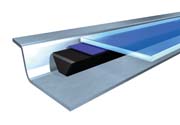Innovations in Glass Bonding

In the fledgling days of the automotive industry, "eat my dust" was the most likely wisecrack uttered by the early car enthusiast when competing for road space with a fellow motorist. It didn't take long to discover that dusters, hats, gloves and goggles were more of an encumbrance than a deterrent to dirt, dust, moisture, bugs, and fumes. This realization sparked the evolution of the glass-enclosed passenger compartment and modern front and rear windshields.
From the early 20th century through the 1950s, windshields were installed as a feature that enhanced passenger comfort by keeping external elements out of the passenger compartment. For OEMs, installation of these large pieces of stationary glass was a cumbersome process that consisted of manually wrangling not only the glass but also a series of gaskets, metal trim, mechanical fasteners, stops, and spacers.
The introduction of polysulfide windshield sealant in 1960 began to change all that. Since then, Dow Automotive* has been at the forefront of innovation in glass bonding technology and systems for the global transportation industry. Within 10 years, Dow Automotive advanced the chemistry to a system of cleaners, primers and polyurethane adhesives that paved the way for today's automated glass installation processes.

All glass bonding systems from Dow Automotive meet Federal Motor Vehicle Safety Standards (FMVSS) and other globally mandated safety requirements for barrier/frontal impact and rollover/roof crush. In addition, we sell our glass bonding products into the automotive and commercial vehicle aftermarkets to ensure that vehicles undergoing glass replacement can have windshields and other stationary glass re-installed with OE quality bonding materials.

- QUICK FIX adhesives are developed with a higher rate of green strength for better assembly efficiencies through reduced need for glass fixture hardware at the OE.
- High-modulus formulations are stiffer than standard polyurethane adhesives and help make the vehicle body more rigid. In addition to strengthening vehicle structure, these adhesives help eliminate vibrational noise, squeaks and rattles to ensure a quieter ride.

- Non-conductive adhesives are available for those vehicles that have antennas integrated into front or rear windshields. The formulation reduces contact corrosion and radio signal attenuation to ensure that audio system performance is not compromised.
- Primerless-to-paint adhesives are specially formulated to eliminate the need for a body primer prior to glass installation. This reduces assembly steps and associated costs, as well as VOC emissions from the assembly environment.
The glass bonding process typically involves a number of products and assembly steps that must be strictly followed to ensure a successful bond. Traditional adhesive formulations require glass to be cleaned, activated and then primed prior to adhesive application, and to prime the body opening as well. Our primerless-to-paint formulations, introduced in 1997, were a first step toward gaining efficiencies by eliminating assembly steps.



Henry Ford, Walter Chrysler and the Dodge brothers would probably never have envisioned that adhesives and sealants could become so integral to the manufacture of automobiles. However, they did possess the vision and imagination to know that anything is possible. Dow Automotive is proud of its heritage of innovation and looks forward to introducing more great ideas, new materials, and technology solutions throughout the 21st century.
For more information on Dow Automotive, visit http://www.dowautomotive.com.
Looking for a reprint of this article?
From high-res PDFs to custom plaques, order your copy today!








